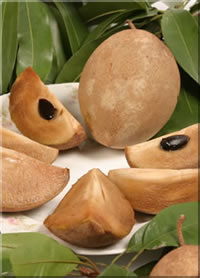From Tropical
Fruit Growers
of South Florida
Cooking with
Sapodilla
Manilkara
zapota

The
sapodilla has been a staple in latin and asian cuisine for hundreds of
years, but is not as popular here in the United States. It’s sweet
taste and pear like texture offer a unique treat for you to try as a
fruit to eat out of hand, or to use in dessert dishes. You will find
sapodillas mostly in latin and asian markets today, but some U.S.
retail grocers are beginning to recognize this delicious fruit and are
stocking it in their produce department.
Selecting
fruit
Sapodillas
are picked from the trees when they are mature,but not ripe. This means
that the fruit has reached its full size and shape,but the starches
inside the fruit have not yet converted to sugar. When those starches
have changed into sugars,usually over a few days of sitting on the
kitchen counter,the fruit will soften and emit a pleasant aroma.
At
the market, look for sapodillas that are free of soft spots,and are not
mishapened. Next,check that the fruit is mature. To do this,gently
scrape a tiny scratch on the sapodilla skin with your fingernail,
noting
the color of the flesh underneath. If that flesh is a deep green, then
that fruit is NOT mature and will not ripen into a sweet fruit no
matter how long you keep it on the counter. If the flesh color has a
hint of yellow – even with some green, then that fruit is mature
and will be able to ripen at home on the counter.
Ripening
When properly
harvested, sapodillas are picked from the trees when they are mature,
but not ripe. This means that the fruit has reached its full size and
shape, but the starches inside the fruit have not yet converted to
sugar. When those starches have changed into sugars, the firm fruit
will soften and be ready to eat.
When you have selected a mature
sapodilla from the market, or received mature sapodillas from our
growers, place the fruit on the counter to ripen in the warmth of the
kitchen. You can also place it in a paper bag to ripen the fruit a bit
earlier. It will usually take a few days for the fruit to ripen.
Sapodillas are ripe when they are soft, like a peach.
Handling
To
eat sapodillas, either cut across the middle of the fruit, remove the
seeds,and spoon out the flesh, or using a sharp knife or potato
peeler. The skin and seeds
of the sapodilla are not edible.
Storage
A
ripe sapodilla will keep in the refrigerator in a plastic bag or
container for about a week. It is possible to delay the ripening of
sapodillas by placing the unripe but mature fruit in a plastic
container in the refrigerator, and then take it out to ripen on the
counter, but you may loose some quality in the fruit.
You can
also freeze sapodillas, but the consistency will change a bit and be
best suited for use in ice creams, breads, pudding and sauces.
Recipes
Sapodillas have
been described as tasting like a pear covered in brown sugar! These
sweet fruits go great in fruit salads, flans, sweet breads, ice creams
and puddings.
Back to
Sapodilla Page
|
© 2020 by Tropical Fruit
Growers of South Florida
|
